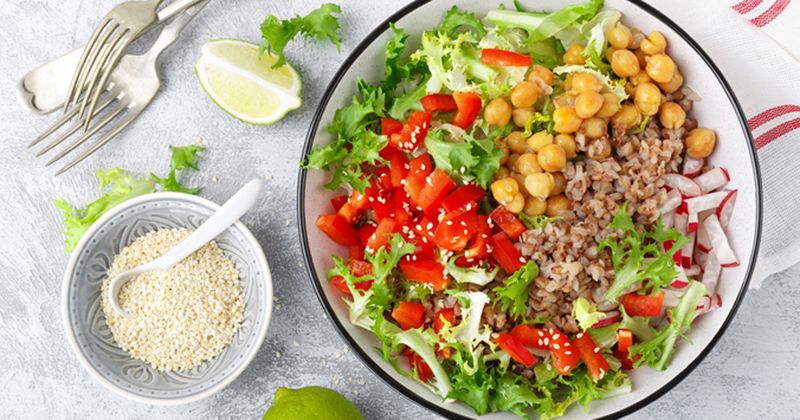Swapping animal protein for plant-based dinner may reduce CV risk by 10%
Click Here to Manage Email Alerts
Adults who substitute low-quality carbohydrate or animal protein at dinner with high-quality carbohydrate or plant protein could reduce cardiovascular disease risk by as much as 10%, according to an analysis of survey data.
In an analysis of National Health and Nutrition Examination Survey data, researchers also found that excessive consumption of low-quality carbohydrate and animal protein at dinner rather than breakfast was associated with increased risk for CVD among U.S. adults, whereas consuming unsaturated fatty acids at dinner was associated with reduced CVD risk. The researchers noted that the study is the first to assess the association between macronutrients and CVD by considering subtypes and meal timing simultaneously, based on national-scale representative data.

“Meal timing along with food quality are important factors to consider when looking for ways to lower your risk of heart disease,” Ying Li, MD, PhD, a professor in the School of Public Health at Harbin Medical University in Harbin, China, said in a press release. “Our study found people who eat a plant-based dinner with more whole carbs and unsaturated fats reduced their risk of heart disease by 10%. It’s always recommended to eat a healthy diet, especially for those at high risk for heart disease, but we found that eating meat and refined carbs for breakfast instead of dinner was associated with a lower risk.”
Assessing diet intake
Li and colleagues analyzed data from 27,911 participants from the 2003-2016 NHANES. Participants completed a 24-hour dietary recall via in-person interview and then by phone 3 to 10 days later. Dietary nutrients and energy intake were estimated using the U.S. Department of Agriculture’s Food and Nutrient Database for Dietary Studies. Six subtypes of macronutrients were derived: high-quality carbohydrates including whole grains, legumes, whole fruits, tomatoes, dark-green vegetables and other red/orange vegetables; low-quality carbohydrates including refined grains, fruit juice, potatoes, other starchy vegetables and added sugars; animal protein including unprocessed red meat, processed meat, poultry, seafood, dairy and eggs; plant protein including whole grains, refined grains, legumes, nuts and soy; saturated fatty acid; and unsaturated fatty acid. The main exposure variable was the ratio of breakfast, the ratio of dinner, and the difference in the ratio of subtypes of macronutrient consumption at dinner vs. breakfast throughout the day. Researchers stratified respondents by quintiles of differences of subtypes of macronutrients at dinner vs. breakfast, and used logistic regression models and isocaloric substitution effects of subtypes to assess risk for CV events.
Risk with low-quality carbs, protein
Compared with the lowest quintile, participants in the highest quintile of the difference in ratio of low-quality carbohydrates had a higher risk for angina (OR = 1.63; 95% CI, 1.16-2.29) and myocardial infarction (OR = 1.47; 95% CI, 1.13-1.93).
The highest quintile of change in ratio of animal protein had a higher risk for coronary heart disease (OR = 1.44; 95% CI, 1.06-1.95) and angina (OR = 1.44; 95% CI, 1.01-2.07) compared with those in the lowest quintile. The highest quintile of the difference in ratio of unsaturated fatty acid was associated with lower stroke risk vs. the lowest quintile (OR = 0.76; 95% CI, 0.58-0.99).
In analyses using isocaloric substitution of low-quality carbohydrates or animal protein with high-quality carbohydrates or plant protein at dinner, researchers found one serving decrease of low-quality carbohydrates consumption with the simultaneous one serving increase of high-quality carbohydrates at dinner could reduce risk for congestive heart failure by 10% (OR = 0.9; 95% CI, 0.82-0.98) and stroke by 12% (OR = 0.88; 95% CI, 0.81-0.96). Additionally, one serving decrease of animal protein consumption with simultaneously one serving increase plant protein at dinner could reduce the risk for congestive heart failure by 10% (OR = 0.9; 95% CI, 0.83-0.98) and MI by 8% (OR = 0.92; 95% CI, 0.86-0.99).
“The association remained robust when considering breakfast skipping and dietary quality, which were classic dietary confounders,” the researchers wrote.
The data show that overconsumption of low-quality carbohydrates and animal protein at dinner rather than breakfast was significantly associated with higher CVD risk, and unsaturated fatty acid consumption at dinner had a lower CVD risk among U.S. adults, they wrote.
“Substitution of low-quality carbohydrates or animal protein by high-quality carbohydrates or plant protein at dinner could reduce CVD risk,” the researchers wrote.

